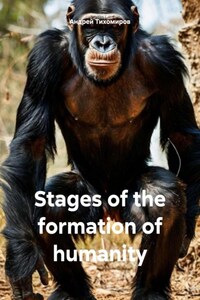Man, a social being with consciousness, reason, a subject of socio-historical activity and culture. Man appeared on Earth during a long and uneven evolutionary process – anthropogenesis. Scientists believe that 8-5 million years ago, African apes split into 2 branches: one led to anthropoid apes (chimpanzees, gorillas, etc.), the other – to the first hominids (Australopithecines), who had a bipedal gait. About 2 million years ago, Australopithecines gave rise to the genus "man" (Homo), the first representative of which many scientists consider "Homo habilis" – his fossil remains are found together with the most ancient stone tools (the so-called Oldowan culture). About 1.6-1.5 million years ago, this species was replaced in East Africa by "Homo erectus". Representatives of this species (archanthropes, paleoanthropes), differing in their morphological features and levels of development, began to spread from Tropical Africa across the continent, as well as into Europe and Asia. About 40 thousand years ago, at the turn of the Upper Paleolithic, Homo sapiens became the only representative of the hominid family and populated almost the entire Earth.
As a biological species, humans have many common features with mammals, primarily primates. Specific features of humans that sharply distinguish them from the animal world are: upright posture, highly developed brain, thinking, and articulate speech. Humans cognize and change the world and themselves, create culture and their own history. The essence of humans, their origins and purpose, and their place in the world have been and remain central issues in philosophy, religion, science, and art.
"Over the past 20 years, members of the international Zoonomia consortium have been decoding the genomes of animals from various families and comparing them with the human DNA sequence. Biologists report that the results of many years of research have allowed them to better understand at what stage of evolution the changes occurred that turned apes into humans. Science has established that the fundamental difference between humans and animals occurred about a million years ago in South Africa. It was based on mutation processes that led to the fact that in areas associated with the development of the brain, the "zone of accelerated human development", the protein packaging of DNA was rebuilt. These areas of the brain of ancient human ancestors accidentally ended up next to enhancers – amplifiers of gene activity, which became a turning point in the history of ancient people. But this accident was also a necessity that arose, in all likelihood, with the change in the food consumed by ancient ancestors, namely the use of food cooked on fire, served as this impetus. In the process of human development, an important role was played by the fact that human ancestors consumed both plant and animal food, this is the period of the early Paleolithic. Such a variety of food had a huge impact on the development of the entire body of human ancestors and especially the brain. Fishing, which developed from the end of the Paleolithic, also brought ancient man new food containing substances important for his development. But the main thing was that ancient man mastered fire and began to cook on it: fry and bake meat, fish, plants. This was done on coals, in hot ashes, on hot stones, in pits lined with stones. These ancient forms of cooking were preserved for a long time by some peoples of Australia and Oceania. Animals, even higher ones, are afraid of fire and avoid it in every possible way. Therefore, fried and boiled food can be eaten only occasionally as a result of waste or by stealing food from a person. It is known that a long stay of a person or an animal on one diet changes the secretory reaction of the glands to food irritants, which is due to a change in the functional state of the food center. The food center is a formation of the central nervous system of humans and higher animals that regulates the intake of nutrients into the body and their processing in the digestive tract. The concept of the food center was introduced by I.P. Pavlov based on his theory of conditioned reflexes. The work of the food center, determined by the degree of satiety of the organism and food stimuli, causes the organism to move for food, to accept food and to secrete digestive juices. Like the respiratory center, the activity of the food center is carried out periodically and is regulated by changes in the chemical composition of the blood, stimuli associated with food intake and agents acting on the interoreceptors of the alimentary tract, which in turn affects the brain. The so-called "hungry blood", that is, the blood of a person or animal several hours after eating, excites the activity of the food center, and "fed blood", on the contrary, delays this activity. The food center consists of separate groups of cells located in various parts of the central nervous system, including the cerebral cortex. The food center is represented mainly by receptive nerve cells, it is under the influence of other nerve centers and itself affects their activity. The change in the food supply of ancient ancestors gradually led to changes in the digestive, nervous, and immune systems and served as an impetus for the formation of the II signaling system. Since ancient times, fire has played a huge role in the lives of people. Its use by humans became the cornerstone of the formation of civilization, rooted in ancient times. A group of archaeologists led by Francesco Berna from Boston University in the United States in 2012 came to the conclusion that humans first began to use fire about 1 million years ago. Scientists came to this conclusion after discovering traces of hearths in the Wonderwerk cave in South Africa. Raw food restrained the growth of brain volume in the ancestors of proto-humans. Insufficient amount of nutrients in raw plant food was the main reason for the small brain volume of distant human ancestors, which confirms the key role of fire and "culinary art" in human evolution, anthropologists say in an article published in the journal Proceedings of the National Academy of Sciences also in 2012. (Tikhomirov A.E., When and Why Did Man Appear? "LitRes", Moscow, 2023, pp. 1-2). Among the questions that have long worried mankind, one of the most difficult is undoubtedly the question of its own origin and genealogy. History does not know of a people that would not draw in one form or another – most often a mythical-religious picture of its appearance on Earth. According to the Bible – the holy book of Jews and Christians – God created man in his own image and likeness on the sixth day of the creation of the world and blessed him to possess the earth and rule over all animals. The Aborigines of Australia were sure that they descended from different animals, for example, from rats, turtles, and the Indians who inhabited the southwest of modern Canada traced their ancestry to the otter; but this is not the same otter as exists today, the Indians said, the otter ancestor was a man-otter, he could change the appearance of a man to the appearance of an otter and turn back into a man. In different parts of the globe, peoples with different cultures had different views on the origin of mankind. To obtain reliable information about how mankind arose, it is necessary to turn to a whole complex of sciences, primarily archeology, anthropology, ethnography.














